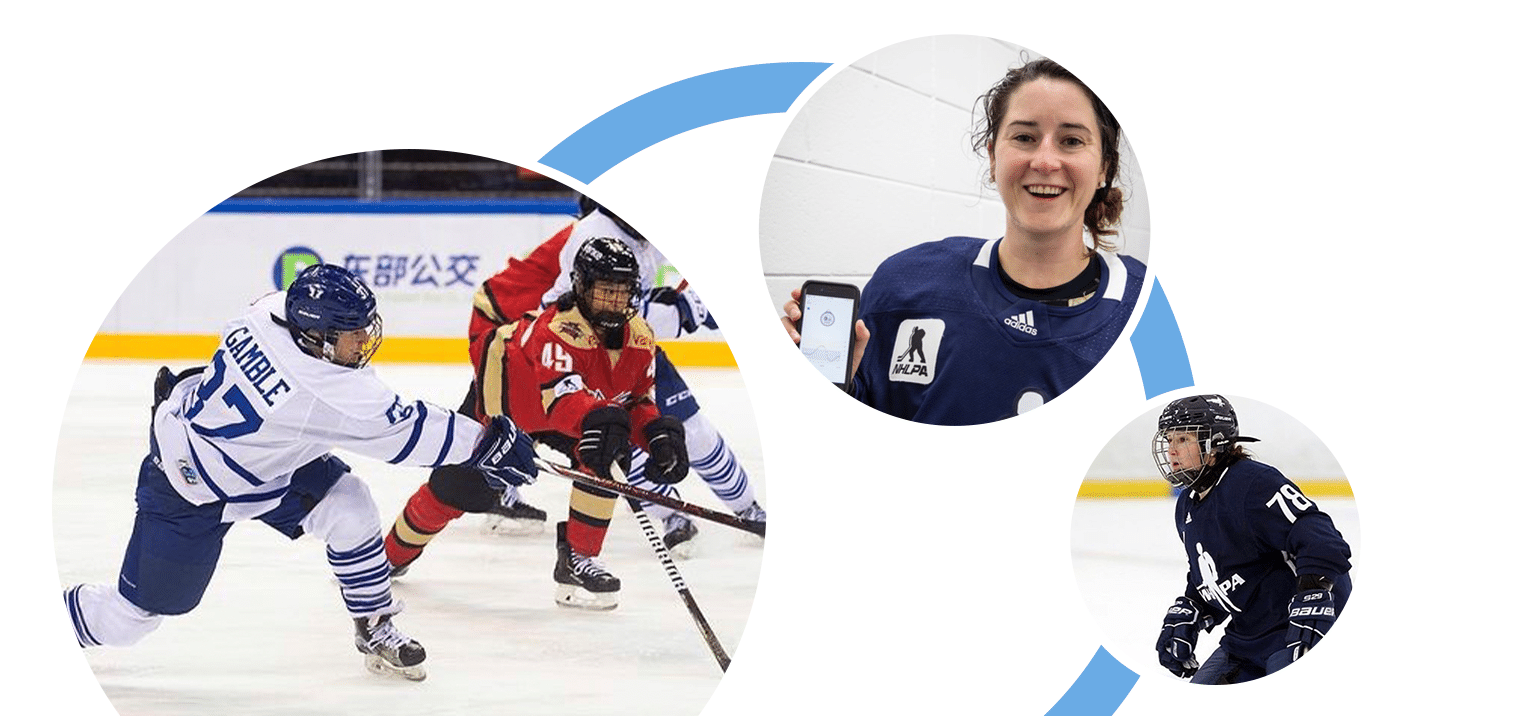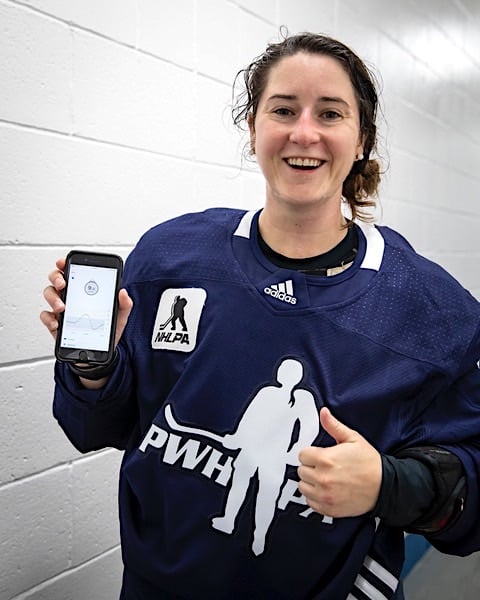
‘You Can Do Anything With Diabetes’: Q&A With PWHPA Hockey Player Anissa Gamble
Anissa Gamble was diagnosed with type 1 diabetes when she was a child. But she didn't let her diagnosis slow her down, becoming a professional hockey player and now working toward a career as a diabetes researcher and clinician. Her message for others living with diabetes? Your diagnosis doesn't have to hold you back.
Anissa Gamble was 8 when she received the diagnosis that would change her life. But even as a child she was determined not to let her diabetes slow her down, becoming a professional hockey player and using her platform to raise a voice for others living with the same condition.
In honor of World Diabetes Day on November 14, we sat down with her to discuss what it’s like being a professional athlete with diabetes, the physical and mental tolls it can bring, and why access to care and support is more important than ever.

You were diagnosed with diabetes as a child. Can you take us back to that moment? How did you find out, and what were your initial thoughts? Did you have any idea you might have diabetes?
First of all, everyone’s story is unique and an incredible thing about both type 1 and type 2 diabetes is that they can be diagnosed at any age. There’s a stigma that type 1 is only diagnosed during the juvenile years, and that type 2 is only in adulthood, but that’s untrue. I was diagnosed when I was 8, so I was really young. For me, I had some classic signs and symptoms: constant urination, frequent weight loss, I was always tired, etc.
My parents were able to observe these clinical signs as my grandmother lived with type 1 diabetes, but she sadly passed away possibly due to diabetes complications before I was born. So as an 8-year-old kid, I personally didn’t really know or understand the significance of the diagnosis, but I think my parents did.
I’ve basically lived with diabetes my entire life, and it affects my family directly; my dad has type 2 diabetes, my grandmother lived with type 1, and my uncle was diagnosed with type 1 later in his life. Because of that, I’ve gotten into diabetes research, and my career goals are now to better understand and implement diabetes management. How can we translate the things we learn in academia into clinical science and how can we apply that into real-life practice?

What are some of the differences between being diagnosed as a child and being diagnosed later in life?
The biggest thing is the lifestyle change. Even when you’re diagnosed, you can’t really comprehend how much it impacts you. It impacts every decision that you do. Putting your diabetes first instead of your sport or something else is probably the biggest transition.
Your age of diagnosis will affect you differently. As a kid, you might feel like diabetes took away a lot of your life, but being diagnosed as an adult is also such a big adjustment. It’s like having a child to take care of. Having that huge transition might be an even bigger impact, because as a child it really becomes your routine. You don’t know anything different than life with diabetes. There’s no good age to be diagnosed with diabetes, because it’ll affect your life in different ways.
Were you worried your diagnosis would impact your ability to play hockey?
I’ve been playing hockey since I was about 3. Luckily, when I was diagnosed, I immediately started thinking, when can I get back on the ice? That was my happy place. I think I was angrier at the fact I had to take a break from hockey rather than being diagnosed with diabetes. But I was pretty fortunate that my parents let me focus on my hockey. They used it as a kind of symbiotic relationship, where if I took care of my diabetes, then I could take care of my hockey training. Having that support system was really critical to my diabetes management and health. So it was a good motivation.
I think I went back on the ice about two weeks after my diagnosis. Getting back into the rink was when it really kicked in for me because I disrupted my routine where I thought, oh, I actually have to test my sugar, have x amount of carbohydrates, or bring a juice box to the bench. That’s when I remember thinking, this is weird, do I have to do this every day now?
 What’s different about being an athlete with diabetes? How have you had to adapt your day-to-day work to accommodate it?
What’s different about being an athlete with diabetes? How have you had to adapt your day-to-day work to accommodate it?
I read a study that indicated that people living with diabetes have to make on average about 180 additional decisions per day. Everything you do, consciously or unconsciously, you have to think about your diabetes. It’s as simple as waking up: What’s my sugar? How many carbs are in this? What’s the glycemic index? If I’m going to go to hockey, do I have a snack with me, do I have extra needles? It’s those extra decisions, especially as an athlete, that create a whole new variable.
To add to the complexity, it’s a multidimensional equation because it’s not just about insulin and carbs, but am I stressed? How much active insulin do I have? We speculate that there are up to 42 factors that can influence your blood sugar management. That has a huge mental toll. That’s something you don’t realize: underneath the iceberg you have all these decisions, and the impact they can have on your daily life is really challenging.
Who have you looked to for support throughout this journey? Would this experience have been harder without a network of support?
Living with type 1 or type 2 diabetes is really lonesome. You can have these support mechanisms around you, but at the end of the day it’s based on your decisions and what you’re doing. I love team sports for this reason. You really do need a team around you. Everyone on your team plays a different role, and this translates to my diabetes as my parents support me by not judging my “high blood sugar” emotions, which is really important. My health care provider team is great. I have a great endocrinologist, nurse, and dietician. My friends had my juice boxes when I was low.
But the biggest support mechanism for me has been talking and associating with people who also live with diabetes. It’s really hard to explain diabetes’ impact to other people, especially those who don’t live with diabetes. Just having people who understand goes a really long way. I’ve been really fortunate to be involved in the diabetes community and be involved with organizations like Diabetes Canada, Connected in Motion, and the Juvenile Diabetes Research Foundation. I’ve met some incredible peers that push me and support me in my diabetes management every day.
So everyone on my diabetes team plays a different role, but we all have the same goal of living/supporting a healthy life with diabetes.

“Living with type 1 or type 2 diabetes is really lonesome. You can have these support mechanisms around you, but at the end of the day, it’s based on your decisions and what you’re doing. I love team sports for this reason. You really do need a team around you.”

Has living with diabetes impacted your mental health in any way? Do you think the mental health aspect of living with diabetes gets enough attention?
There’s a really interesting research realm called “diabetes distress” that talks about things like depression or anxiety that are related to diabetes. It’s a misunderstood or overlooked aspect of diabetes as so many things affect our mental health regarding diabetes, but we aren’t taught and don’t understand its significance in the patient, clinical, or research field.
There are different categories, but one aspect would be in clinician or friend relationships, where it can be tiring talking about things like your A1C values or your nutrition. Having to advocate for yourself in groups like explaining your diabetes or having devices attached to you 24/7 is tiring. The financial burden of diabetes is massive. Insulin is the sixth-most expensive liquid in the world, but you also need to afford test strips or syringes, CGM, insulin pumps, etc. It really adds up!
Without good health insurance, living with type 1 or type 2 is extremely difficult. It’s constantly in your head: am I going to afford my next shot of insulin? Then there are the secondary complications. Am I going to lose a limb? Am I going to go blind? It can be pretty scary.
At a micro level, fear of hypoglycemia is another challenge. I’m always carrying juice boxes or other kids of sugar with me because there’s that fear. Those things really add up in your head. The easy part is taking the needles and testing your sugar. The hard part is trying to figure it all out and trying to live your life.

Access to care seems like it would be a real burden to a lot of people who have diabetes.
I’m from Canada, and we estimate that 1 in 3 people live with diabetes or pre-diabetes. Think about a room of people — that is so many people. It’s just so common that we don’t realize it. Access to care is something that really motivates me, especially as I hopefully become a clinician in the future.
I’ve been fortunate to live across Canada, and the access is so different place to place, especially in a universal health care system. But even affording insulin is still a battle. In a developing country, people might not even have any access to insulin. They might have to walk miles and miles to access care. That’s something that really scares me to think about, but it also motivates me, because there’s a huge gap and a lot more work that we need to do. Diabetes is definitely growing in prevalence and we must take action before it gets worse.
Though the conditions are different, what do people with type 1 and type 2 have in common?
A lot of people don’t understand there are so many types of diabetes. Mostly we talk about type 1 and type 2. The majority of people, about 90%, have type 2, and about 10% have type 1. They’re very different disorders, but they do have a lot of commonalities.
The biggest commonality I have with my peers and my father living with type 2 is the mental aspect. There’s stigma with both disorders. Both can be diagnosed at any age. type 1 might come down to insufficient insulin production, whereas type 2 could be because of your liver, kidney, fat cells, or insulin, but they all come down to blood glucose levels. At the end of the day, you still have the common goal of trying to have good glycemic management and good mental health. I think sometimes separating the two might be doing some harm, because there is a lot of overlap. Both of them have their own unique challenges and one is not better than the other.
What made you want to get involved with Athletes for Hope and use your voice to speak out about living with diabetes?
For me, growing up I’ve always been very curious. I think that’s why I’m dedicating my whole life to diabetes. I’m a female athlete, I’ve been playing hockey since I was 3, and I’ve played professionally. The ability of a female athlete to make a living playing hockey or in any sport is really challenging. For me, I never had representation. To my knowledge, I’m the first female who lives with type 1 diabetes to play professionally in North America, and I’ve only played with one other female hockey player who lives with diabetes. That’s something I want to change.
It’s so important for people with diabetes to see others who are doing other things and being involved with the cause. I just hope that what I do can resonate with people and give them the motivation to keep going and just be the best person they can possibly be. It’s an avenue that I’m really thankful for.
I know I wish I could have seen someone growing up, especially a female hockey player or researcher who lives with type 1. That would have made it a little less lonesome.

What message would you share with people who have diabetes, especially young people?
My favorite quote ever is, “Smooth seas never make a skillful sailor.” You can do anything living with diabetes, whether you have type 1 or type 2. It just might be a little harder than the person next to you. But you have to realize that the prize isn’t the destination of getting to that certain goal; it’s actually about the life lessons and the journey that you get throughout it. That’s the true gift of life, getting to hone in on those challenges and use them. Because at the end of the day, I truly believe that living with diabetes or any chronic disorder has the ability to make you a better person. To utilize that and become the best person you can possibly be — that’s the true meaning of life.
How you can help
Make a lifesaving gift to support our work now and for the future at projecthope.org/donate
Are you a health-care or other professional who would like to learn more about volunteering abroad with Project HOPE? Learn more about our volunteer program and join our volunteer roster.
Stay up-to-date on this story and our lifesaving work around the world by following us on Facebook, Instagram, LinkedIn and Twitter, and help spread the word by sharing stories that move and inspire you.
 What’s different about being an athlete with diabetes? How have you had to adapt your day-to-day work to accommodate it?
What’s different about being an athlete with diabetes? How have you had to adapt your day-to-day work to accommodate it?